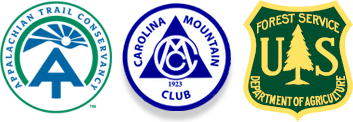
Roan Highlands

Background
Much like Max Patch, Roan Mountain is a famed Appalachian bald on the North Carolina and Tennessee border - renowned for its spectacular views and unique ecology. The Roan Highlands area encompasses a 20-mile mastiff and includes several peaks. Roan’s grassy balds represent the highest quality and longest linear stretch of this community type remaining in the southern Appalachians.

Issues at Roan Highlands
-

Parking/road hazards
Easy accessibility and scenic views have led to increased visitor use. Social media publicity and continued promotion for events have exacerbated this issue. The current parking demand greatly exceeds capacity at Carver’s Gap. Cars frequently park haphazardly along highway beyond the Gap in both directions -creating dangerous situations
-

Off trail hiking and camping
Many visitors have been venturing off trail and damaging sensitive plants and wildlife habitat. The Roan Highlands area hosts an assortment of rare, threatened, and endangered species that depend upon its unique ecosystem. Extensive social trail creation from hikers, campers, photographers, blueberry pickers, and more are threatening Roan’s unique species.
-

Resource/habitat damage
Littering, off trail hiking, vandalism, illegal “green” wood harvesting, and more are creating widespread damage to Roan’s natural resources and habitat. Sensitive trees are being killed by campers harvesting live wood from trees, while fire rings are sterilizing the soil and abandoned trash, human waste, and campsite materials are posing risks to both Roan’s ecosystems and visitors.

Why It Matters
These conditions are especially worrisome since the Roan Highlands area is home to so many sensitive species that depend on its unique ecosystems. In addition to dozens of rare and endemic species, the region hosts five federally endangered species and one federally threatened species. This includes three endangered plants (Roan Mountain bluet, rock gnome lichen, and spreading avens), one threatened plant (Blue Ridge goldenrod), and two endangered animals - the Carolina northern flying squirrel (pictured) and spruce fir moss spider. As such, protecting this area is critically important.
Image: N.C. Wildlife Resources Commission

Invasive species such as the balsam wooly adelgid beetle, habitat destruction, and pollution are some major threats to these species. The beetle destroys trees that the Carolina northern flying squirrel and spruce fir moss spider depend upon. Hikers and campers who leave trash behind and cut wood from trees pose major risks to these species. Many sensitive plants at Roan can also be hurt by human touch. The Gray’s lily, for example, has been decimated by Lily Leaf Spot Disease – a fungal disease which is spread by human contact.
Image: Appalachian Trail Conservancy

How You Can Help:
Stay on official trails only.
Do not touch plants.
Always follow the 7 Leave No Trace principles.
Never cut live wood from trees or bring in outside firewood.
Only camp and hike in designated areas.
Use the boot brush at the entrance to remove any potential invasive species from shoes.
Always pack out trash and human waste.

Conclusion
Both Max Patch and Roan Highlands are popular recreation sites in a beautiful region of the southern Appalachians. Additionally, both sites are home to a unique array of plants and wildlife that depend upon their exceptional ecological offerings. High elevation Appalachian balds are increasingly rare and require special attention. Since these areas are of high importance for both recreation and conservation purposes, it is crucially important that visitors take care in treating the environment with respect and compassion.



